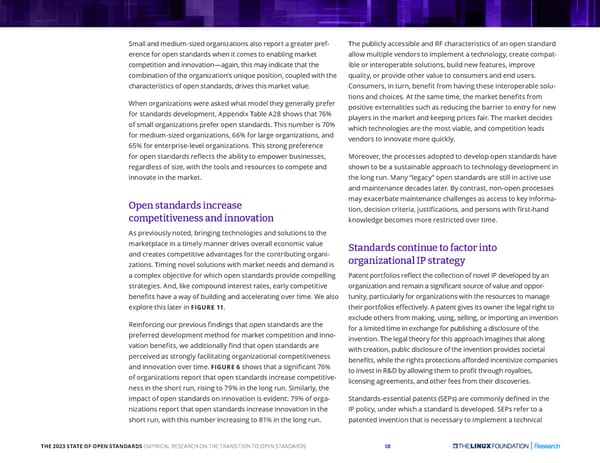Small and medium-sized organizations also report a greater pref- The publicly accessible and RF characteristics of an open standard erence for open standards when it comes to enabling market allow multiple vendors to implement a technology, create compat- competition and innovation—again, this may indicate that the ible or interoperable solutions, build new features, improve combination of the organization’s unique position, coupled with the quality, or provide other value to consumers and end users. characteristics of open standards, drives this market value. Consumers, in turn, benefit from having these interoperable solu- tions and choices. At the same time, the market benefits from When organizations were asked what model they generally prefer positive externalities such as reducing the barrier to entry for new for standards development, Appendix Table A28 shows that 76% players in the market and keeping prices fair. The market decides of small organizations prefer open standards. This number is 70% which technologies are the most viable, and competition leads for medium-sized organizations, 66% for large organizations, and vendors to innovate more quickly. 65% for enterprise-level organizations. This strong preference for open standards reflects the ability to empower businesses, Moreover, the processes adopted to develop open standards have regardless of size, with the tools and resources to compete and shown to be a sustainable approach to technology development in innovate in the market. the long run. Many “legacy” open standards are still in active use and maintenance decades later. By contrast, non-open processes Open standards increase may exacerbate maintenance challenges as access to key informa- tion, decision criteria, justifications, and persons with first-hand competitiveness and innovation knowledge becomes more restricted over time. As previously noted, bringing technologies and solutions to the marketplace in a timely manner drives overall economic value Standards continue to factor into and creates competitive advantages for the contributing organi- organizational IP strategy zations. Timing novel solutions with market needs and demand is a complex objective for which open standards provide compelling Patent portfolios reflect the collection of novel IP developed by an strategies. And, like compound interest rates, early competitive organization and remain a significant source of value and oppor- benefits have a way of building and accelerating over time. We also tunity, particularly for organizations with the resources to manage FIGURE 11. their portfolios effectively. A patent gives its owner the legal right to explore this later in exclude others from making, using, selling, or importing an invention Reinforcing our previous findings that open standards are the for a limited time in exchange for publishing a disclosure of the preferred development method for market competition and inno- invention. The legal theory for this approach imagines that along vation benefits, we additionally find that open standards are with creation, public disclosure of the invention provides societal perceived as strongly facilitating organizational competitiveness benefits, while the rights protections afforded incentivize companies FIGURE 6 shows that a significant 76% and innovation over time. to invest in R&D by allowing them to profit through royalties, of organizations report that open standards increase competitive- licensing agreements, and other fees from their discoveries. ness in the short run, rising to 79% in the long run. Similarly, the impact of open standards on innovation is evident: 79% of orga- Standards-essential patents (SEPs) are commonly defined in the nizations report that open standards increase innovation in the IP policy, under which a standard is developed. SEPs refer to a short run, with this number increasing to 81% in the long run. patented invention that is necessary to implement a technical THE 2023 STATE OF OPEN STANDARDS EMPIRICAL RESEARCH ON THE TRANSITION TO OPEN STANDARDS 18
 The 2023 State of Open Standards Page 17 Page 19
The 2023 State of Open Standards Page 17 Page 19